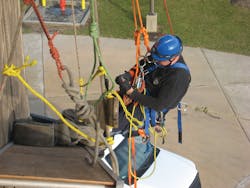While a very practical and efficient fire service tool, the topic of rope for firefighters has been met with a broad range of acceptance (and resistance) within the ranks. However, while most companies have bags of rope on most every apparatus, what surprises me is the lack of its use and the widespread opposition to even taking it out of the compartment when it would be an obvious solution to the tasks at hand.
That being said, I am going to make a significant attempt to get the fire service to rekindle its love and respect for the world of rope in both utility and life-safety settings.
Begin the journey
If you recall from your days at recruit school, many types of rope and cord exist for use within the emergency services. We generally decide on the type of rope to be used based on the task it must perform, but all rope work includes a certain amount of danger within the operation.
Rescuers must remember that there are safety rules that must be enforced any time we are working around rope:
• The “STOP!” rule – Anyone at any time can yell “STOP!” and all operations cease movement with the rope. It doesn’t mean drop and let go; it means that anyone with rope in their hands holds tight and all movement of the load stops until the problem is identified and addressed so the evolution can continue.
• On-scene inspection – Every knot, system and device is checked BY LOOK AND BY FEEL prior to loading the system. This inspection is done as a cross-check; if the lowering team built the lowering system, someone else inspects the system to confirm its safe use.
• Testing before trying – All anchors, systems, harnesses and associated devices within the system will be loaded PRIOR to movement on rope. This loading procedure helps to identify any potential problem areas, such as pinch points for harnesses and packaging, friction areas for rope travel and any potential overloading issues with the systems.
• Redundant systems – Along with a main line, a secondary belay line system will be constructed and operated along with the main rope system.
• The “no-brainers” – It should go without saying, but I will say it anyway – there is NO EXCUSE for anyone smoking, using alcohol or drugs or standing on, dragging or creating friction while rope is in use. The type of operation is dangerous enough, and we shouldn’t be adding to the risk.
Selecting a rope
Rope selection is determined by the use; either utility or life safety. An example of utility use would be lifting a tool, hoseline or other object to an elevated area. Any time there is a live (victim) load on a rope, the operation would fall under the life-safety use.
After determining the use, the next selection is the material the rope is constructed from. Natural fiber materials are cost effective, but they contain limited fiber lengths that are woven together to make the rope length. Furthermore, they begin to deteriorate and rot the instant they are cut from the earth. These traits make this type of rope unacceptable for life-safety use.
Synthetic fiber materials do not rot, and are made from continuous filament fibers throughout the entire length of the rope. Moreover, some synthetics can resist heat, float and provide greater flexibility than natural fibers. This makes synthetic fiber rope the material of choice for life safety usage.
Consider the amount of the load and the safety factor for the task being done. Focusing on life-safety use, there are times when a victim and a rescuer may be moving on the same systems. National Fire Protection Association (NFPA) 1983: Standard on Life Safety Rope and Equipment for Emergency Services identifies a safety factor of 15 when working with live loads on rope. In a scenario where a victim and an attendant are being lowered to the ground from above, the attendant (rescuer) is assigned a weight of 300 pounds. The victim is also assigned a weight of 300 pounds to compensate for materials and packaging used in moving the victim to safety, bringing the total weight of the load to 600 pounds. Considering a safety factor of 15 into the equation, a life-safety rope used for a two-person load would need a minimum recommended strength of 9,000 pounds. For our needs, a two-person rescue rope is a minimum of half-inch-diameter nylon static kernmantle rescue rope.
Rope care and use
Rope care is not limited to the times when it is placed into service. Rope inspections should be done at least every month and after every use. Anytime there is a bend placed into the rope, it weakens the area of the rope. The most common type of bend in a rope is a knot. Knots weaken the efficiency of the rope; that is, it lessens the strength of the rope by a percentage based upon the characteristics of the knot. While the straight (tensioned) section of rope may measure at 100% efficiency, some knots can weaken the rope by over 40% just by tying the knot in the rope. Friction, abrasion and weak areas in the rope only compound this issue. This is why many rescuers do not recommend pre-rigging systems and leaving the knots in place, as it stresses the cords and places memory in the areas of the knotted end.
Proper rope care includes the “ICS of Rope Maintenance” – inspection, cleaning and storage of rope. When inspecting rope, it is inspected by look and feel for the “A-B-C-D-S” of rope:
• Abrasions – A significant amount of the outer sheath may have signs of abrasion after continued usage. Wear that starts to approach 50% wear through the sheath will retire a rope.
• Bumps (and soft spots) – A bump or soft area means that the inner core of the rope has suffered significant damage and the rope is retired.
• Cuts – Obviously, any cuts will retire the rope.
• Dirt – Depending on the material, the rope may be cleaned with a soft detergent or with the use of a rope washer. Any hydrocarbon exposure, such as fuels, oils and greases, will retire the rope. This author has seen a coiled section of rope left in a compartment that also housed the fuel cans for the fans and generators on the apparatus. The end result was a 200-foot wick (rope) that had to be destroyed.
• Shock load – A shock load occurs when an object in motion is met with an equal force in the opposite direction of travel that stops movement suddenly. This shock load can be dangerous to victims and rescuers, and can cause sudden and catastrophic failure to the rope system. Any rope that has experienced this will be retired from use.
Simply put, WHEN IN DOUBT, THROW IT OUT! Any question about the integrity of the rope should ultimately remove it from service
Once the inspection is completed, the inspection should be documented on the department rope log. This is a source of documentation as to the history of the rope’s life within the department. Areas to be documented include the manufacturer of the rope; the lot and serial numbers; the in-service date; color and markings; and a list of the usage of the rope. Usage should include the date it was used; the type of usage; any wear on the rope, and a total of cumulative hours that the rope has been in service.
Storing the rope on the apparatus for possible deployment is best suited in a rope bag. The bag helps keep the rope cleaner, protects it from damage, and allows for a quick deployment of the rope than any other storage method. Be sure to use a compartment that is well ventilated and away from the exhaust system discharge for the vehicle.
Conclusion
There are a lot of considerations when selecting the right rope for the task to be performed. Hopefully, our discussion has jump-started the interest in getting back into the rope bags and revisiting the various uses and techniques associated with rope.
Next time, we will discuss some basic rigging and anchor systems that can be deployed quickly and efficiently with successful outcomes.
MIKE DALEY is a lieutenant and training officer with Monroe Township, NJ, Fire District 3 and an instructor at the Middlesex County Fire Academy, responsible for Fire and Rescue Training Curriculum development. Daley also is a rescue officer with the New Jersey Task Force 1 – Urban Search and Rescue team. He holds certifications as Rescue Technician, Incident Safety Officer, Hazardous Materials Specialist and On-Scene Incident Commander, EMT, Level II Fire Instructor, SCBA/Smokehouse and Live Burn Instructor, Fire Inspector, and Fire Officer. Daley holds degrees in business management and public safety administration. He is the founder and senior consultant for Fire Service Performance Concepts. He may be contacted at [email protected].

Michael Daley
MICHAEL DALEY, who is a Firehouse contributing editor, is a 37-year veteran who serves as a captain and department training officer in Monroe Township, NJ. He is a staff instructor at multiple New Jersey fire academies and is an adjunct professor in the Fire Science Program at Middlesex County College. Daley is a nationally known instructor who has presented at multiple conferences, including Firehouse Expo and Firehouse World. His education includes accreditations as a Chief Training Officer and a Fire Investigator, and he completed the Craftsman Level of education with Project Kill the Flashover. Daley is a member of the Institution of Fire Engineers and a FEMA Instructor and Rescue Officer with NJ Urban Search and Rescue Task Force 1. He operates Fire Service Performance Concepts, which is a training and research firm that delivers and develops training courses in many fire service competencies.






